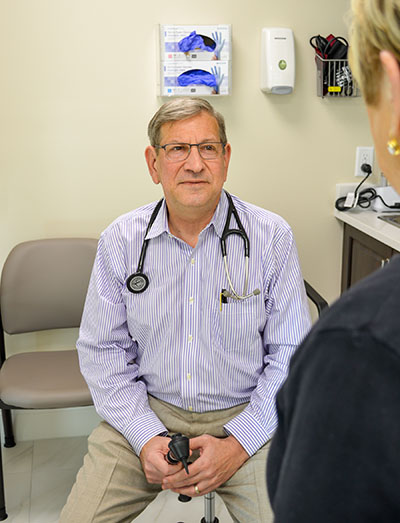Concierge Health Care

This growing trend is changing the traditional doctor-patient relationship
In recent years, a growing number of doctors have embraced a concierge model of patient care, also referred to as personalized, direct primary care or retainer medicine. This service involves a direct financial relationship between physician and patient, with an annual fee or retainer to receive enhanced access, personalized attention, and a comprehensive approach to health care needs.
The increasing popularity of these practices suggests a need to address a growing concern in the current health care system — especially for affluent patients seeking more personalized and comprehensive care. Physicians are attracted to this model for the freedom it provides to spend more time with patients and reduce administrative burdens, along with an increase in job satisfaction.
Dr. Nancy Baker, a family practice physician with Complete Coastal Direct Primary Care in Vero Beach, spent the past two decades as an employee of larger family practices, where she averaged about 2,000 patients each year. With her new direct primary care practice, she limits her patient load to 300-400, a number she achieved within her first six months. She is now compiling waiting lists for future patients. Her new approach to delivering health care is based on a membership fee which gives her select patients unlimited access to her via phone, email, text and in-office visits. This yearly fee covers all or most primary care services including clinical and consultative services, care coordination and comprehensive care management.
“Basically, direct primary care is a way to take care of people where you don’t have insurance as a factor,” she explained. “It’s more like a membership fee at the gym where you pay a yearly fee and you can come and go as many times as you want to. My patients can pay monthly, quarterly or annually. Anything that is done in my office is included in that fee. If you come to the office for a visit, that’s included. If we give you a B-12 shot, that’s included. If we stitch up a wound, that’s included. If it’s necessary for me to make a home visit, even that’s included.”
‘GOOD MEDICINE’

“To practice good medicine, I needed a place where I could take my time to really get to know my patients and to be an advocate for them when a specialist or hospitalization is needed,” Baker said. “So much of medicine today involves impersonal care dictated by middle men. The Direct Primary Care [DPC] model gives the power back to the physician and the patient by taking insurance out of the equation. I don’t have to worry about the red tape and box checking that comes with a fee for service model where there is a triangular relationship with the doctor, the insurance company and the patient. The purpose of me doing this concierge type model wasn’t really profit-driven. Instead, it gives me the ability to practice medicine the way I want to, where I know my patients.”
With reduced patient loads, physicians practicing concierge medicine can establish stronger relationships with their patients. Emphasis is placed on preventive care, wellness and proactive health management complete with comprehensive health assessments, personalized health plans and coordination of specialty care.
A University of Wisconsin report revealed that nearly half of primary physicians today devote less than 15 minutes to each patient visit which the typical patient has about 1.6 times a year, while concierge physicians spend about 35 minutes on each visit with patients averaging four visits a year.
INSURANCE STILL REQUIRED
Concierge care is not an insurance alternative. Members of a concierge practice still need to have proof of insurance in case they need to go to the emergency room, be referred to a specialist, need lab work, or require care that can’t be provided by their concierge doctor. Since routine care is covered by your membership, though, you could consider switching to a high deductible health plan to save money.
“It’s a matter of quality versus quantity,” said Dr. Hal Brown, of Primary Concierge Vero who has been practicing primary care medicine for 31 years and is currently transitioning to the concierge medicine model. “The medical business today is very complicated. The reimbursement to physicians generally goes down every year and the cost of providing care goes up every year. This formula is not sustainable and has brought about the development of concierge medicine.”
Traditionally, insurance companies dictate what physicians can order, prescribe, and how much they will be reimbursed for services. Those numbers have been unfavorable to providers for years and are getting worse with cutbacks to Medicare and Medicaid. In addition, it’s increasingly difficult for doctors to get certain medicines, diagnostic tests and appointments with specialists for their patients. Concierge medicine allows the physician to more easily navigate and orchestrate the care of patients while at the same time giving them access in a timely fashion so they can be treated quickly and efficiently.
The affordability of the concierge model varies depending on the physician and the level of service provided. Annual fees can range from $1,200 to $10,000 and they are out-of-pocket expenses, not covered by insurance. For this reason, the concierge model is more accessible to individuals with high incomes. However, some physicians offer different tiers of membership, providing more affordable options for patients.
While the concierge model offers undeniable benefits to those who can afford it, there should be consideration on its potential impact to the broader health care system. Critics argue the increasing popularity of this model might exacerbate the existing disparities in access to health care, as it primarily caters to the rich. Proponents argue the concierge model fosters innovation and encourages physicians to deliver higher quality care, potentially driving improvement across the health care industry.
As the health care landscape continues to evolve, the concierge model provides a compelling alternative that challenges the traditional insurance-doctor-patient dynamic and has the potential to elevate the level of care for those who can access it.
See the original article in print publication
Sept. 26, 2023
